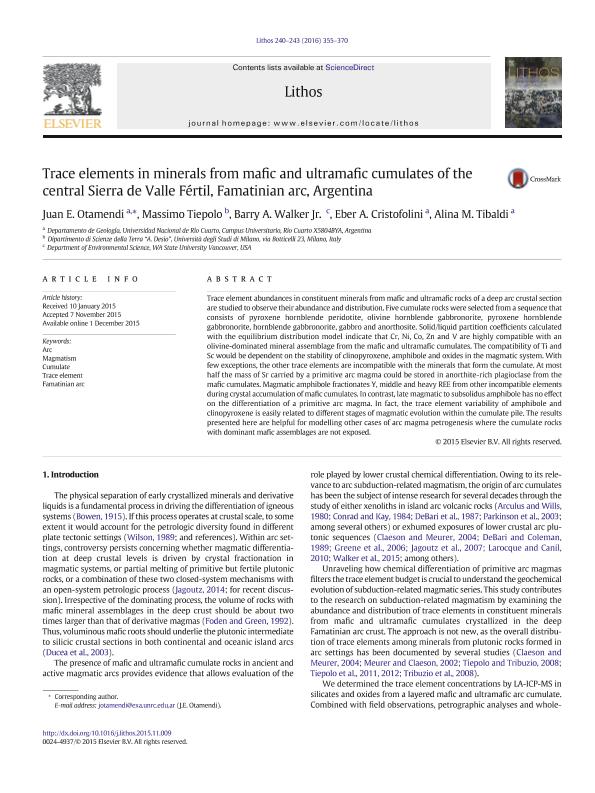Mostrar el registro sencillo del ítem
dc.contributor.author
Otamendi, Juan Enrique

dc.contributor.author
Tiepolo, Massimo
dc.contributor.author
Walker, Barry A.
dc.contributor.author
Cristofolini, Eber Ariel

dc.contributor.author
Tibaldi, Alina María

dc.date.available
2022-11-30T18:53:11Z
dc.date.issued
2016-01
dc.identifier.citation
Otamendi, Juan Enrique; Tiepolo, Massimo; Walker, Barry A.; Cristofolini, Eber Ariel; Tibaldi, Alina María; Trace elements in minerals from mafic and ultramafic cumulates of the central Sierra de Valle Fértil, Famatinian arc, Argentina; Elsevier Science; Lithos; 240-243; 1-2016; 355-370
dc.identifier.issn
0024-4937
dc.identifier.uri
http://hdl.handle.net/11336/179634
dc.description.abstract
Trace element abundances in constituent minerals from mafic and ultramafic rocks of a deep arc crustal section are studied to observe their abundance and distribution. Five cumulate rocks were selected from a sequence that consists of pyroxene hornblende peridotite, olivine hornblende gabbronorite, pyroxene hornblende gabbronorite, hornblende gabbronorite, gabbro and anorthosite. Solid/liquid partition coefficients calculated with the equilibrium distribution model indicate that Cr, Ni, Co, Zn and V are highly compatible with an olivine-dominated mineral assemblage from the mafic and ultramafic cumulates. The compatibility of Ti and Sc would be dependent on the stability of clinopyroxene, amphibole and oxides in the magmatic system. With few exceptions, the other trace elements are incompatible with the minerals that form the cumulate. At most half the mass of Sr carried by a primitive arc magma could be stored in anorthite-rich plagioclase from the mafic cumulates. Magmatic amphibole fractionates Y, middle and heavy REE from other incompatible elements during crystal accumulation of mafic cumulates. In contrast, late magmatic to subsolidus amphibole has no effect on the differentiation of a primitive arc magma. In fact, the trace element variability of amphibole and clinopyroxene is easily related to different stages of magmatic evolution within the cumulate pile. The results presented here are helpful for modelling other cases of arc magma petrogenesis where the cumulate rocks with dominant mafic assemblages are not exposed.
dc.format
application/pdf
dc.language.iso
eng
dc.publisher
Elsevier Science

dc.rights
info:eu-repo/semantics/openAccess
dc.rights.uri
https://creativecommons.org/licenses/by-nc-sa/2.5/ar/
dc.subject
ARC
dc.subject
CUMULATE
dc.subject
FAMATINIAN ARC
dc.subject
MAGMATISM
dc.subject
TRACE ELEMENT
dc.subject.classification
Geología

dc.subject.classification
Ciencias de la Tierra y relacionadas con el Medio Ambiente

dc.subject.classification
CIENCIAS NATURALES Y EXACTAS

dc.title
Trace elements in minerals from mafic and ultramafic cumulates of the central Sierra de Valle Fértil, Famatinian arc, Argentina
dc.type
info:eu-repo/semantics/article
dc.type
info:ar-repo/semantics/artículo
dc.type
info:eu-repo/semantics/publishedVersion
dc.date.updated
2022-11-30T12:05:08Z
dc.journal.volume
240-243
dc.journal.pagination
355-370
dc.journal.pais
Países Bajos

dc.journal.ciudad
Amsterdam
dc.description.fil
Fil: Otamendi, Juan Enrique. Universidad Nacional de Río Cuarto; Argentina. Consejo Nacional de Investigaciones Científicas y Técnicas; Argentina
dc.description.fil
Fil: Tiepolo, Massimo. Università degli Studi di Milano; Italia
dc.description.fil
Fil: Walker, Barry A.. Wa State University Vancouver; Estados Unidos
dc.description.fil
Fil: Cristofolini, Eber Ariel. Universidad Nacional de Río Cuarto; Argentina. Consejo Nacional de Investigaciones Científicas y Técnicas; Argentina
dc.description.fil
Fil: Tibaldi, Alina María. Consejo Nacional de Investigaciones Científicas y Técnicas; Argentina. Universidad Nacional de Río Cuarto; Argentina
dc.journal.title
Lithos

dc.relation.alternativeid
info:eu-repo/semantics/altIdentifier/doi/http://dx.doi.org/10.1016/j.lithos.2015.11.009
dc.relation.alternativeid
info:eu-repo/semantics/altIdentifier/url/https://www.sciencedirect.com/science/article/abs/pii/S0024493715003928
Archivos asociados
